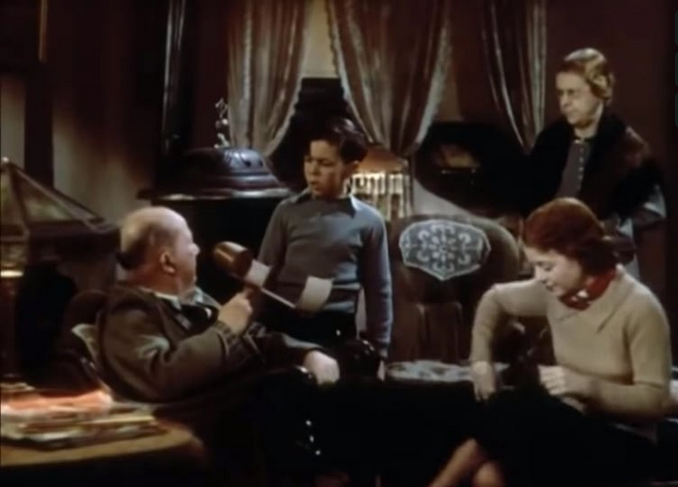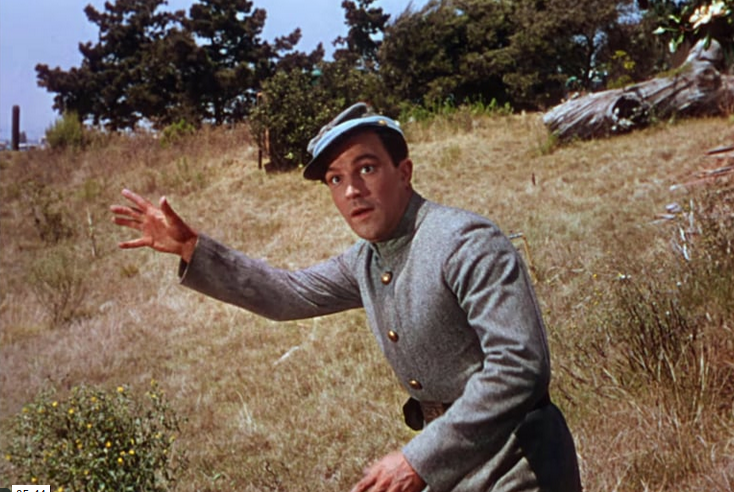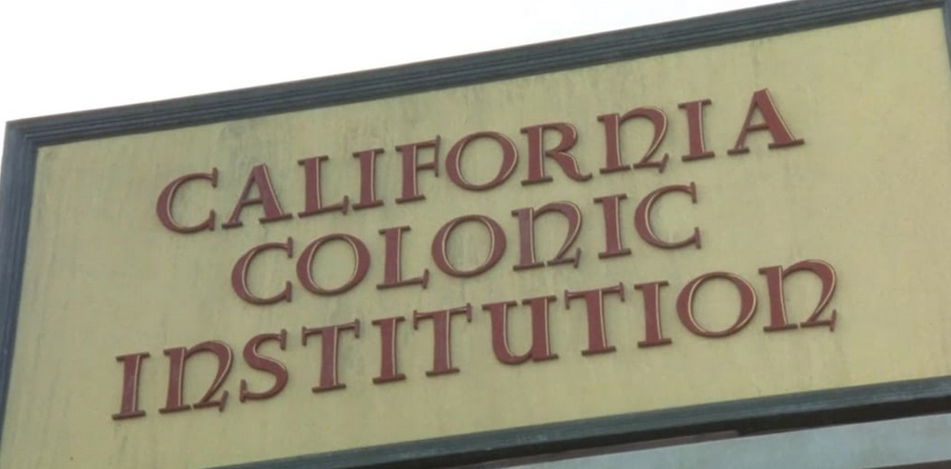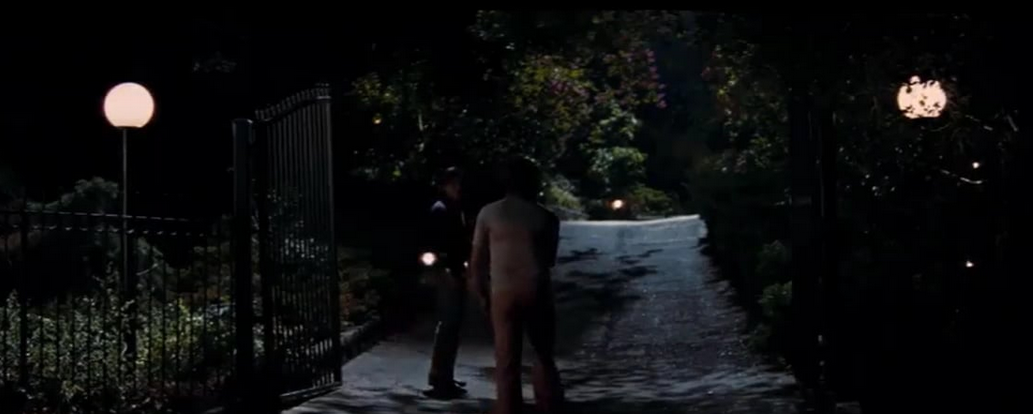LA Aspirations
Before Hollywood was known around the world as the center of film production and culture, it was a suburban housing development advertised in 1923 with a big white-lettered "Hollywoodland" sign in the hills. Early 20th-century filmmakers were attracted to the area for its year-round good weather, consistent sunshine, and varied local scenery. As film grew in popularity as a form of popular entertainment, Hollywood came to be a metonymy for all the dreams, hopes, and promises that enchanted filmgoers across the country. The movie magic projected on theater screens and later in our living rooms presented an idealized image of Los Angeles as a space in which adversity could be overcome and dreams could come true.
A Star is Born (1937)
Though later versions starring Judy Garland, Barbara Streisand, and Lady Gaga may be more familiar to modern audiences, the first version of A Star is Born flickered into theaters with Janet Gaynor playing Esther Blodgett, a nobody from North Dakota who arrives in Los Angeles with hopes of fame and fortune. Through a combination of luck and talent, Esther becomes movie star Vicki Lester while falling in love with Norman Maine, a Hollywood heartthrob haunted by alcoholism. Though Norman falls victim to the temptations of city and cinema life, Esther finds her future in the lights of Hollywood. Her success embodied the hope and promise that Hollywood, and more broadly Los Angeles, offered in the first half of the 20th century.
Hollywood Studio Club
Esther Blodgett’s character is representative of many young women that came to Hollywood to pursue dreams of film stardom. The women in this Young Women's Christian Association photograph were some of many who moved to Los Angeles with hopes of making it big. The YWCA’s Hollywood Studio Club began in a library basement in 1916 as a reaction to this influx of young, unmarried women, and aimed to provide a safe community space for them to study and practice their craft. The need for a safe space became more urgent as silent film era scandals imperiled the industry's good image. Major studios and actors participated in a fundraising campaign to construct a building designed by Julia Morgan that opened in May 1926, almost exactly a year before this photograph was taken.
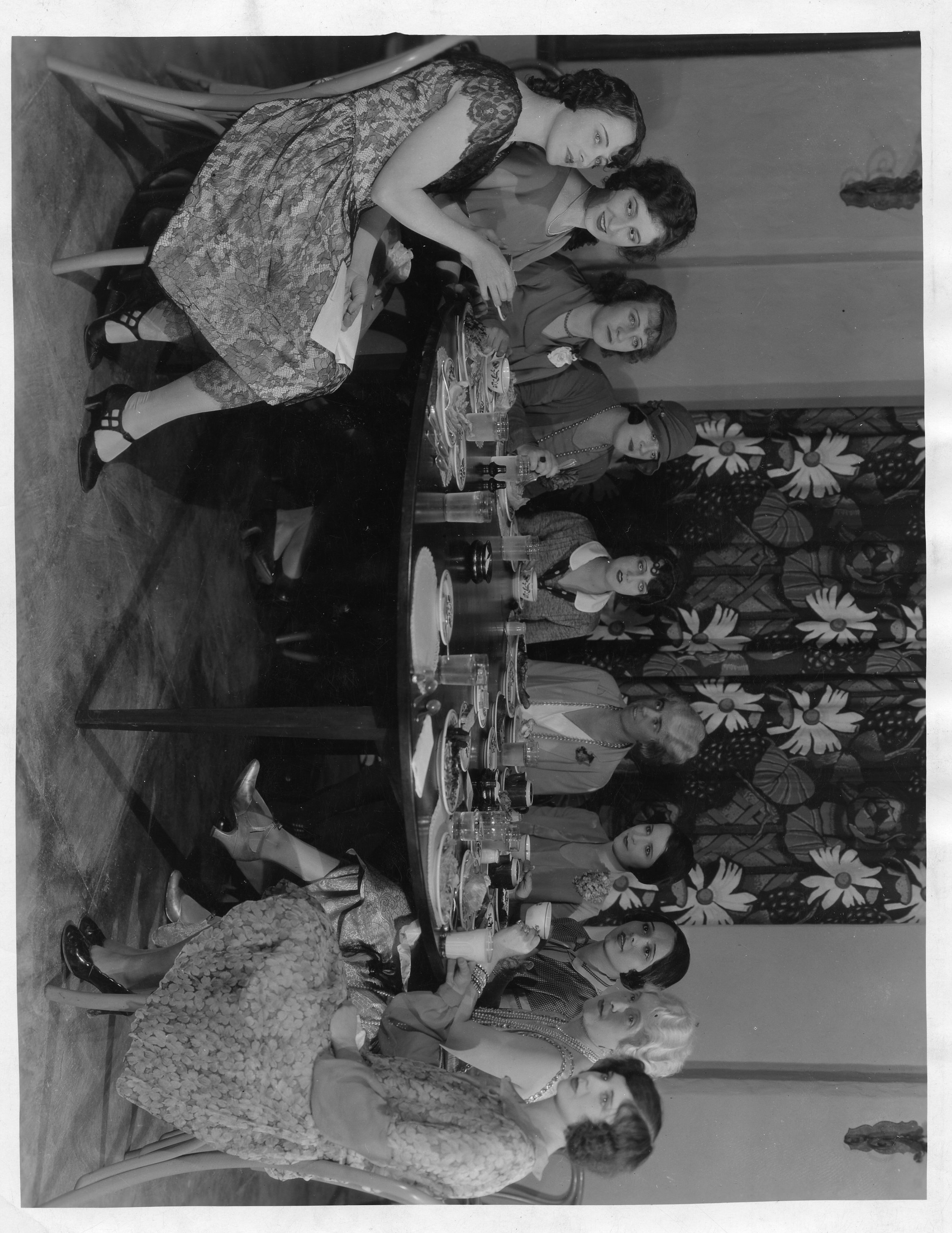
"Hollywood Guide"
The "Hollywood Guide" packages the fantasy and glamour of Hollywood into a handy guide on how to access an exclusive Hollywood lifestyle. The guide includes home addresses of many movie stars and photographs of locations where they dined and danced, like Club Trocadero and The Russian Eagle. In A Star is Born Esther runs into her idol Norman Maine while working an event as a waitress. Part of the mythology of Hollywood is the idea that simply being in the right place at the right time can lead to your discovery. Both A Star is Born and the "Hollywood Guide" imply that success can result from chance encounters with those who have already achieved it.
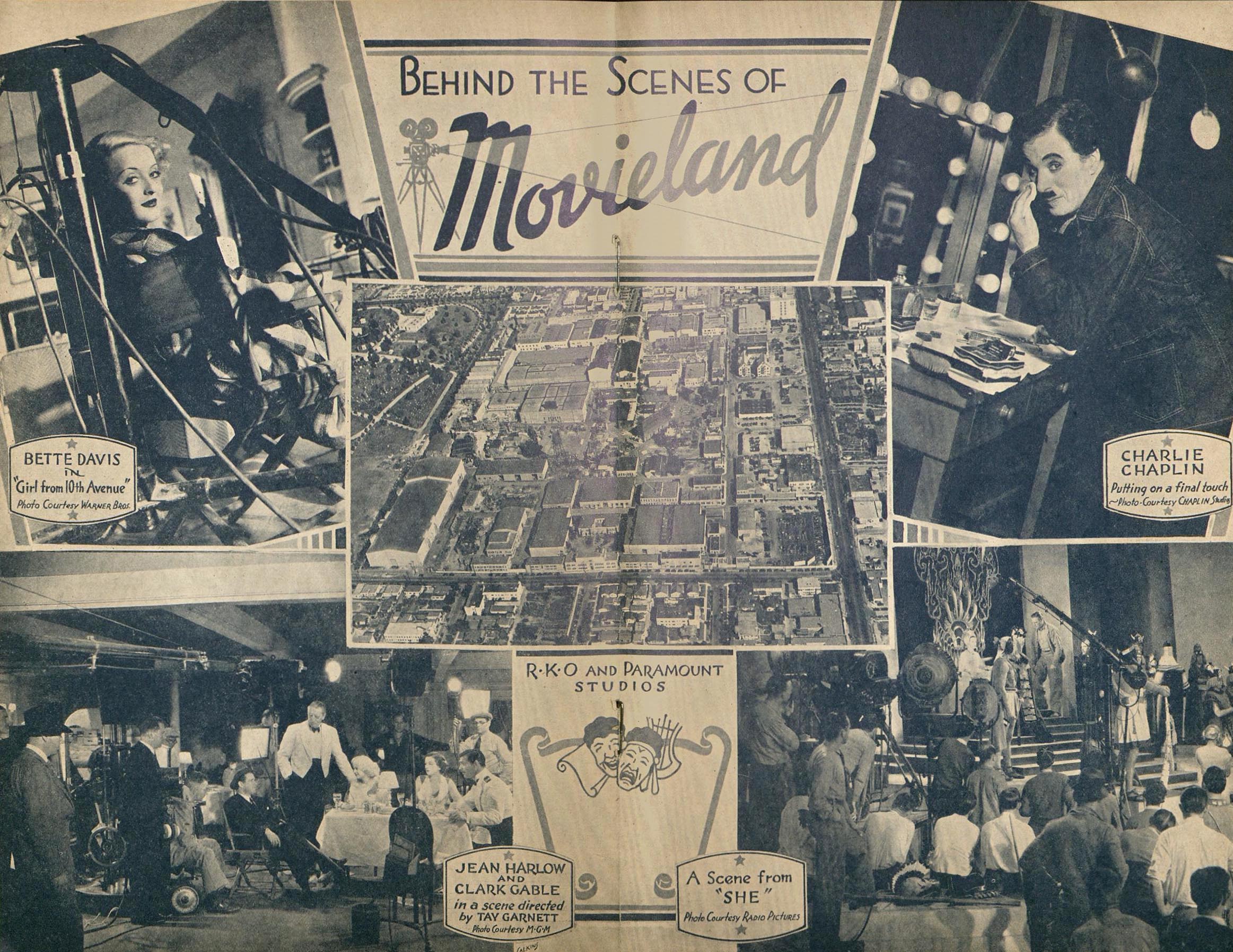
View Accessible Text Transcript (PDF)
Grauman's Chinese Theatre
Grauman's Chinese Theatre, built by American showman Sid Grauman, featured Cecil B. DeMille's silent epic The King of Kings at its 1927 opening. The Chinese Theatre was part of a 1910s movement to show films in lavishly decorated movie palaces that wowed audiences with their surroundings. Ten years after its debut as a movie palace, the Chinese Theatre served as the setting of a tribute celebration to Esther, with her stage name "Vicki Lester" strung in lights across the front of the theatre. Closing A Star is Born at a real, iconic Hollywood location added a sense of weight and reality to the fictional character's success. Like real Hollywood stars in the 1930s, Esther's arrival at Grauman's Chinese Theatre solidified her position in the glittering firmament of Hollywood.
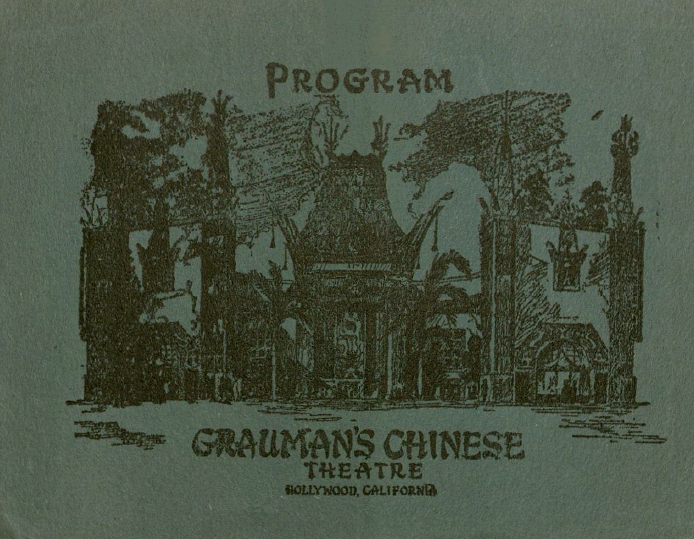
View Full Program (PDF)
View Accessible Text Transcript (PDF)
Singin' in the Rain (1952)
The musical Singin' in the Rain stars Gene Kelly as fictional movie star Don Lockwood. Lockwood became famous acting in silent films as half of an "it" couple with co-star Lina Lamont at the close of the silent film era. As the film starts, Lockwood is a household name, yet when he encounters aspiring actor Kathy Selden at a Hollywood party she claims not to know him. While they initially dislike each other, Don and Kathy eventually realize they make a good team. With the help of Lockwood's best friend Cosmo Brown, the trio save the talking film their studio is producing. Singin' in the Rain provides a fictionalized backstage perspective of the film production industry at the dawn of the "talkies," as films with synchronized dialogue supplanted silent films.
Sammy Davis, Jr.
Sammy Davis, Jr. was a talented entertainer famous for his work as a singer, musician, actor, and comedian. This photo depicts Davis when he was part of the Will Mastin Trio, a singing and dancing group comprised of Davis, his father Sammy Davis, Sr., and his adopted uncle Will Mastin. In Singin' in the Rain, Don Lockwood conceals his past as a vaudeville performer. Like Lockwood, Davis' early performing days with his family were in vaudeville. Sammy Davis Jr.'s skills in dancing were impressive, but his vocal and acting skills were also so good that he stood out when part of the trio. Parallel to Lockwood, Davis, Jr. would eventually perform alongside Frank Sinatra, Dean Martin, Peter Lawford, Joey Bishop, and other artists that consisted of both musical and stage performers.
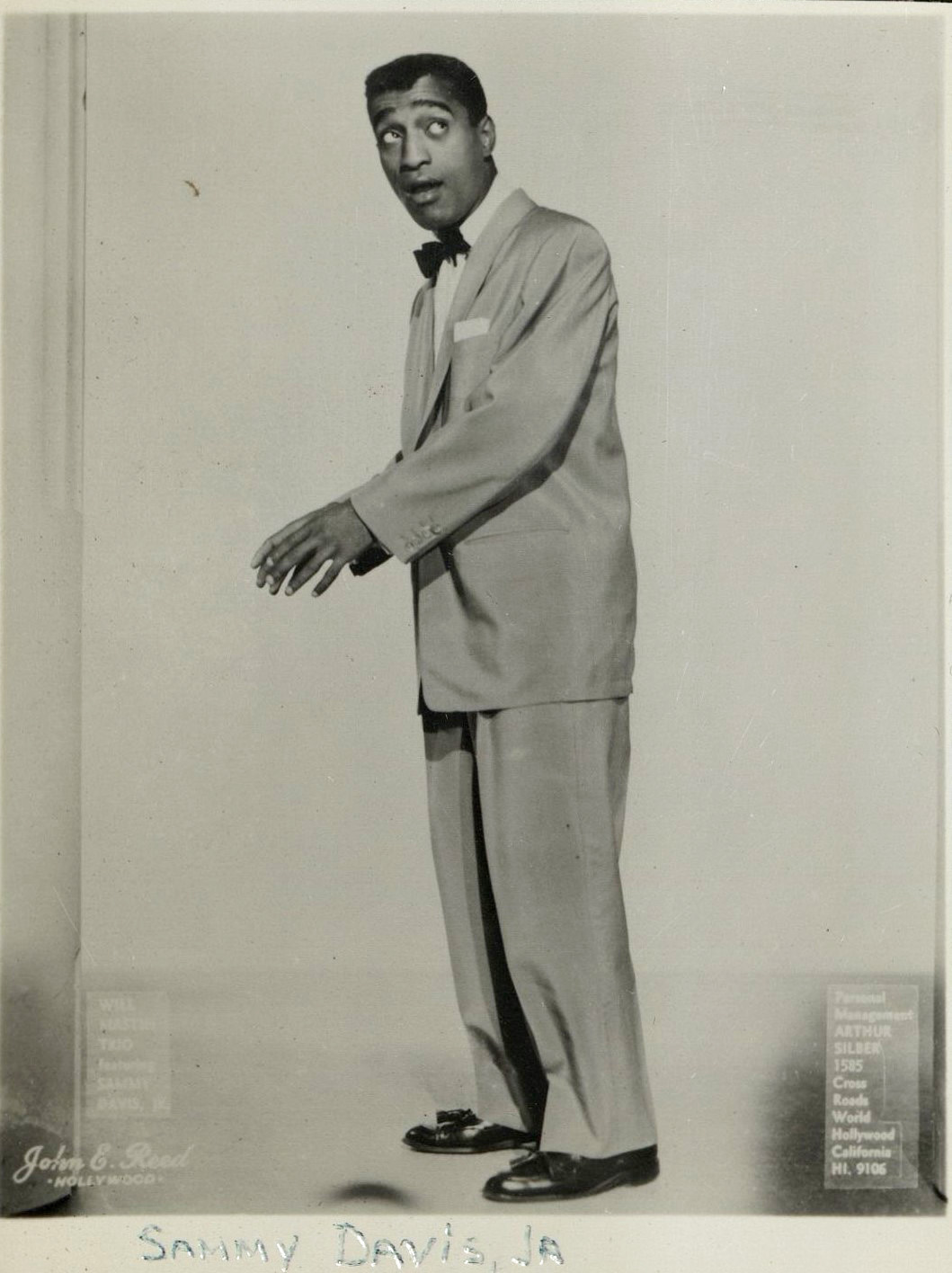
Gold Diggers of 1937
As in most films, a large number of people worked behind the scenes on Gold Diggers of 1937. In the movie Singin' in the Rain there are many views similar to this one that show us the different ways in which movies are actually created. Throughout the film, we see chorus lines and performance groups. Indeed, when Kathy Selden met Don Lockwood, she was one of the many women in Los Angeles who performed in chorus lines while aspiring to become an actor.
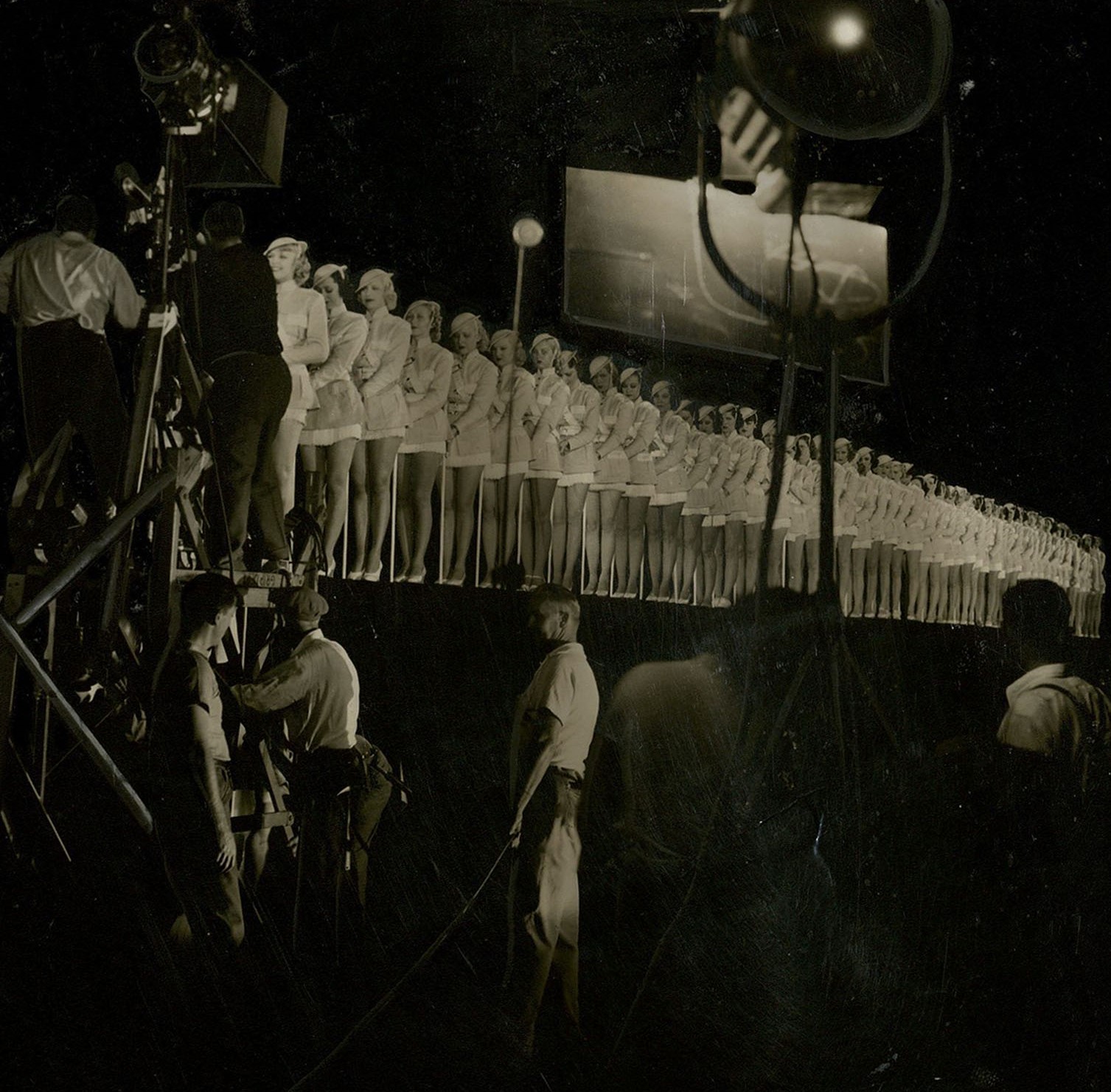
Bing Crosby
Bing Crosby was well known for acting and singing in films such as White Christmas (1954), Holiday Inn (1942), and Anything Goes (1936). Lockwood, like Crosby, was a household name, and during events portrayed in the film, he became known for his singing, too. At the peak of Lockwood's silent movie career, fans often sought his autograph. In one scene in the film, fans even wanted articles of his clothing. The scene is dramatic due to the screaming stampede of fans, unlike the image of Crosby relaxing with a friend in box seats at a public event. Both Lockwood and Crosby had similar fame in their career as singers and actors, so much so that they were constantly recognized while doing everyday things.
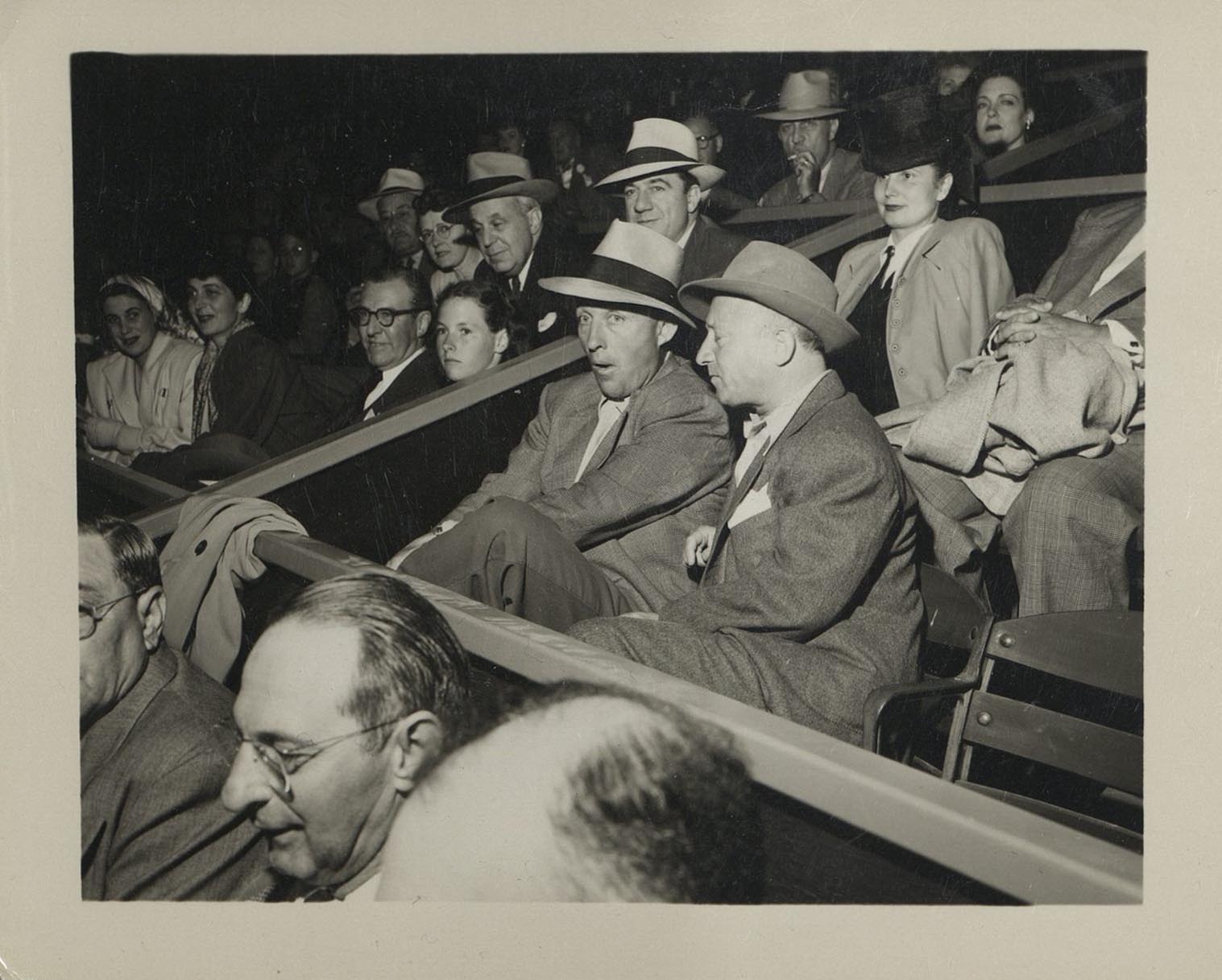
La Bamba (1987)
La Bamba is based on the life of Ricardo Esteban Valenzuela Reyes, better known as singer Ritchie Valens. The film follows Valens' family from Northern California's farmland to Southern California's San Fernando Valley. Valens attends school at San Fernando Valley High, where he meets his high school sweetheart and the alleged inspiration for his song "Donna." While still in high school, he joins musical group The Silhouettes and is discovered by a Del-Fi Records music producer. Although the film focuses on Ritchie, La Bamba shows the difficulties and triumphs of a Mexican-American family in Los Angeles in the mid-20th century. After they move to Los Angeles they find new opportunities, and after Valens' musical success, he is able to purchase a home for his mother in the San Fernando Valley. Despite the tragic early ending to Valens' life and career, the film shows his humble beginnings, the heights of his fame, and his legacy.
Farm Worker Housing
A farm worker stands with children in front of a structure that may be their living space. These small homes for families were made of various materials, including wood and metal. La Bamba shows Valens' family living and working on a farm in Northern California in similar conditions. That home is in stark contrast to the house Valens buys his mother in the San Fernando Valley after he finds fame and fortune in Los Angeles.
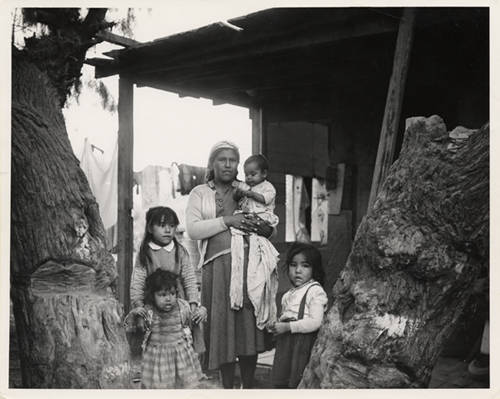
Romance de Amor
Vicente Gomez was a composer and guitarist whose career, like Ritchie Valens', began in an unexpected place - a bar. Gomez immigrated to the United States and made friends with prominent figures. This led him to land a job composing and performing in the film Blood and Sand in 1941. This piece is one of the songs from the film, though not the original as can be noted from the date. Like Richie Valens and Gomez, many musicians and actors sought opportunities and fame in Los Angeles.
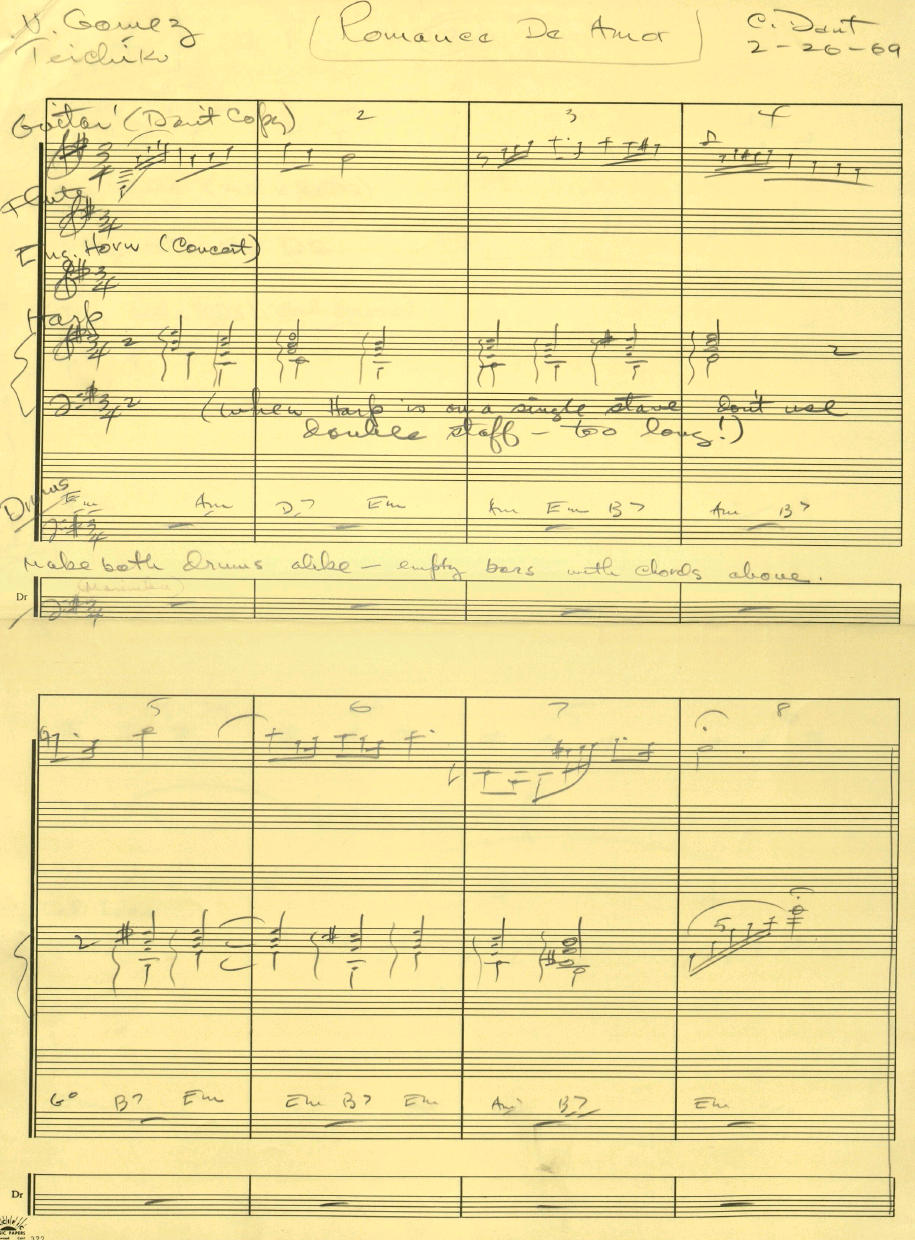
View Full Manuscript (PDF)
Hollywood Walk of Fame
The Arleta Chamber of Commerce supported the addition of the Ritchie Valens star on the Hollywood Walk of Fame as they believed Ritchie Valens was a role model for young people in the San Fernando Valley community. They also mention Pacoima Junior High School's "Ritchie Valens Day." Since Valens' death, there have been many events commemorating his life. In the film, Valens is given accolades for being a good person. This letter states that he was "an outstanding citizen" and an inspiration to young people as he gained fame while remaining "clean, dedicated, and an exemplary person." Valens' hard work, dedication, passion, and talent earned him success and money to help build his family's life in Los Angeles.
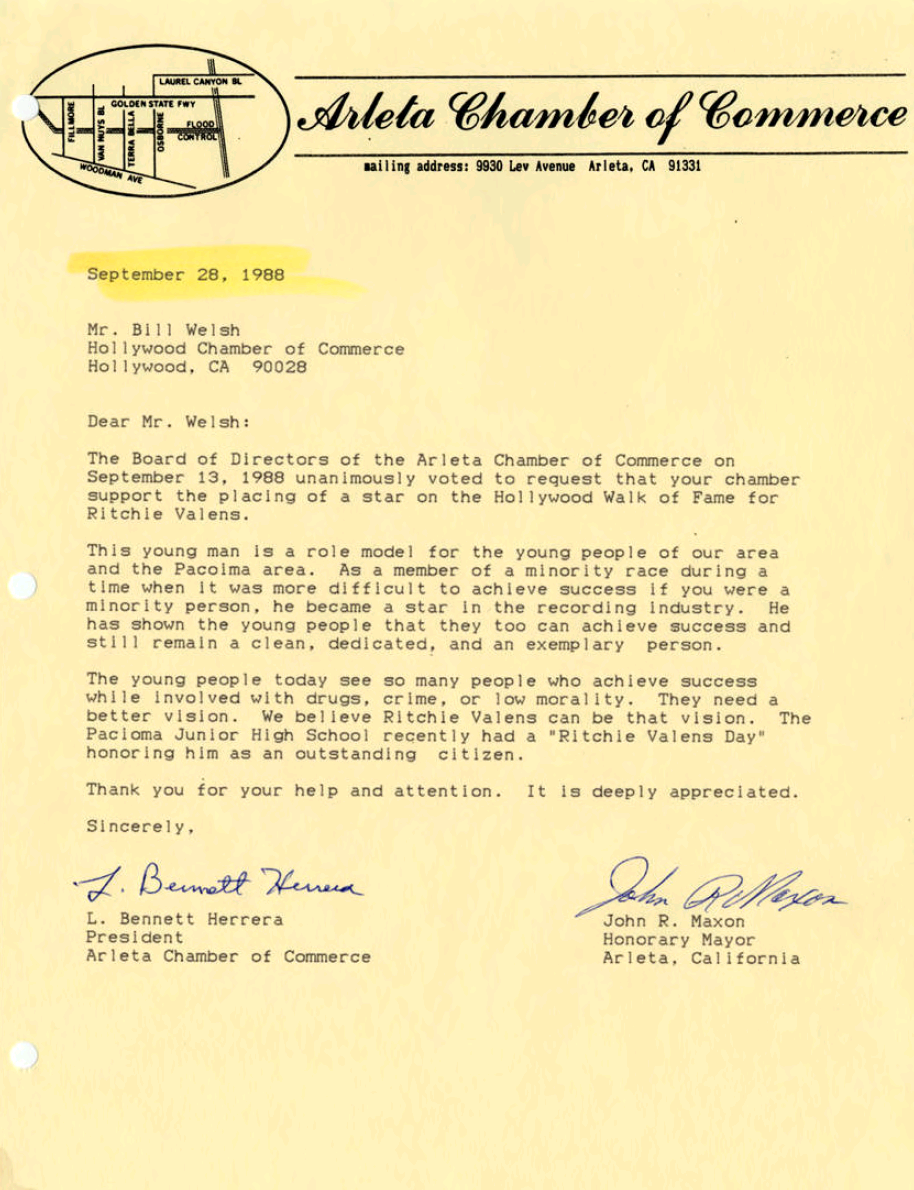
View Document (PDF)
L.A. Story (1991)
L.A. Story is a lighthearted tour of some of Los Angeles' most infamous stereotypes, from earthquakes to bad traffic to alternative medicine. Weatherman Harris K. Telemacher is looking for love and meaning in life in LA in the early 1990s. Bored with his pretentious girlfriend, he starts looking for love with the youthful, trendy, and alternative health adherent SanDeE*. Along the way, a broken freeway traffic sign displaying the message "L.A. wants 2 help u" becomes his impromptu relationship therapist. His traffic sign ally guides him in the direction of a better romantic match. Although the parodied stereotypes are rooted in truth, the presentation of LA as a light and whimsical place overlooks numerous issues the city faced in the early 1990s. The romantic, funny fairytale Telemacher experiences is couched in a privileged Westside viewpoint, where gunshots on the freeway are laughed off or taken in stride. Telemacher ultimately finds love and greater meaning among the wackiness of parodied Los Angeles – a city that is ultimately full of hope despite its vapid clichés.
San Curo
In L.A. Story Telemacher and SanDeE* go to the California Colonic Institution. As they exit, Telemacher remarks, "It was a great lunch and enema, thanks!" The film mocks Los Angeles as a site of quirky health and wellness remedies. In the 19th century, medical professionals lauded Southern California's moderate climate as a cure for respiratory illnesses, in particular. In 1899, the San Curo Medical Company, based in Los Angeles, used that reputation to sell purported cures endorsed by LA residents for myriad ailments including rheumatism, kidney disease, and constipation. Images of orange groves, snow-clad mountains, the Pacific Ocean, and missions ground the curative properties of their products in a romantic and idealized Spanish California past that never really existed. Although San Curo printed the brochure decades before Telemacher had his bowels cleaned out at Venice Beach, the mythologizing of Los Angeles as a center of health and wellness was alive and well long before L.A. Story.

View Additional Pages (PDF)
Center for the Healing Arts
The Center for the Healing Arts offered dialogues and workshops, clinic programs, healing arts workshops, transformational support and training groups, free community services, and books and tapes. The welcome letter from Executive Director Gina Thompson notes "[i]t has been proven that a highly developed creative purpose induces the will to live and may well represent the most potent force within human reach." Thompson emphasizes a need for "focusing on quality, not quantity." This echoes the search for meaning that Telemacher experiences in L.A. Story, as he searches for a life less focused on the pretension and posturing that his first girlfriend exemplifies. Telemacher’s adventures in the city are filled with the hope that he can create an existence filled with more meaning.
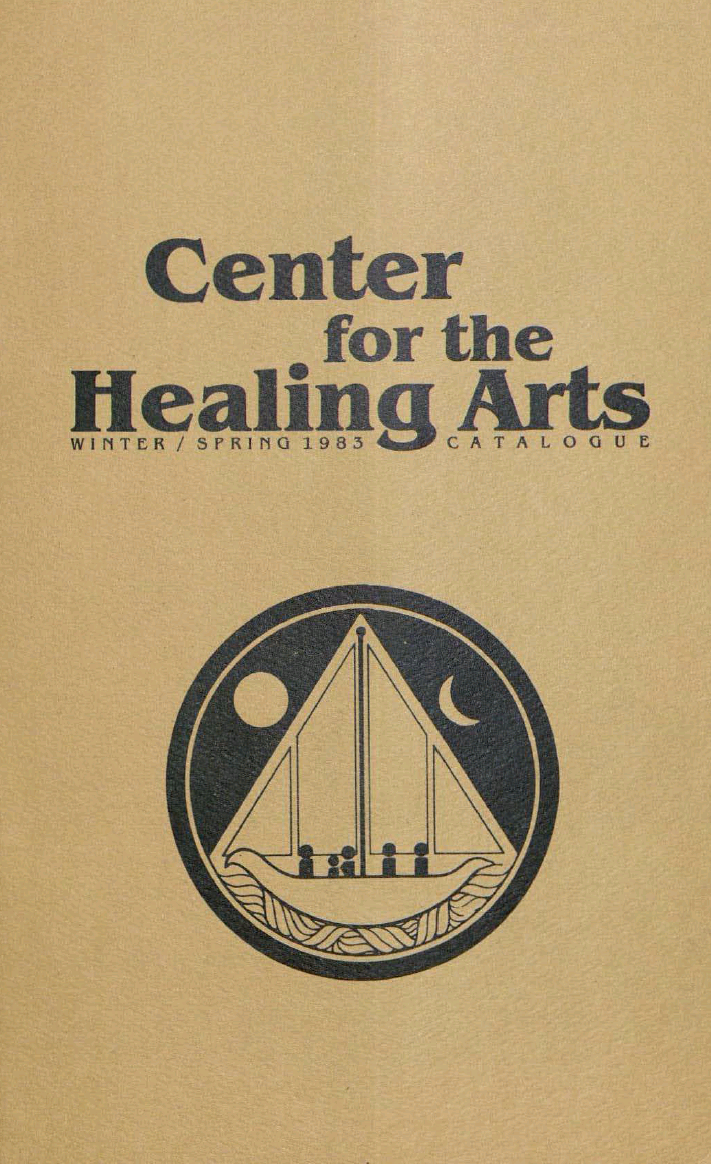
View Additional Pages (PDF)
Weather Station Logbook
In L.A. Story, meteorologist Harris Telemacher's "wacky weekend weather report" provides little real information, and instead highlights the insignificance of an LA weatherman while parodying Los Angeles' consistent temperatures. Although Telemacher's weatherman comedy routine makes light of LA's famously pleasant weather and the role of meteorologists, the study of Los Angeles weather is legitimate and real, as seen in this page from the Los Angeles Weather Station Log Books. These are the administrative records of the weather station, and include names and schedules of meteorologists and observers, equipment, inspections, and weather conditions from October 21, 1905 to June 20, 1938. Although the year-round sunshine and the picturesque snow on distant mountains still hold appeal, contrary to Telemacher's reports, weather in LA does matter.
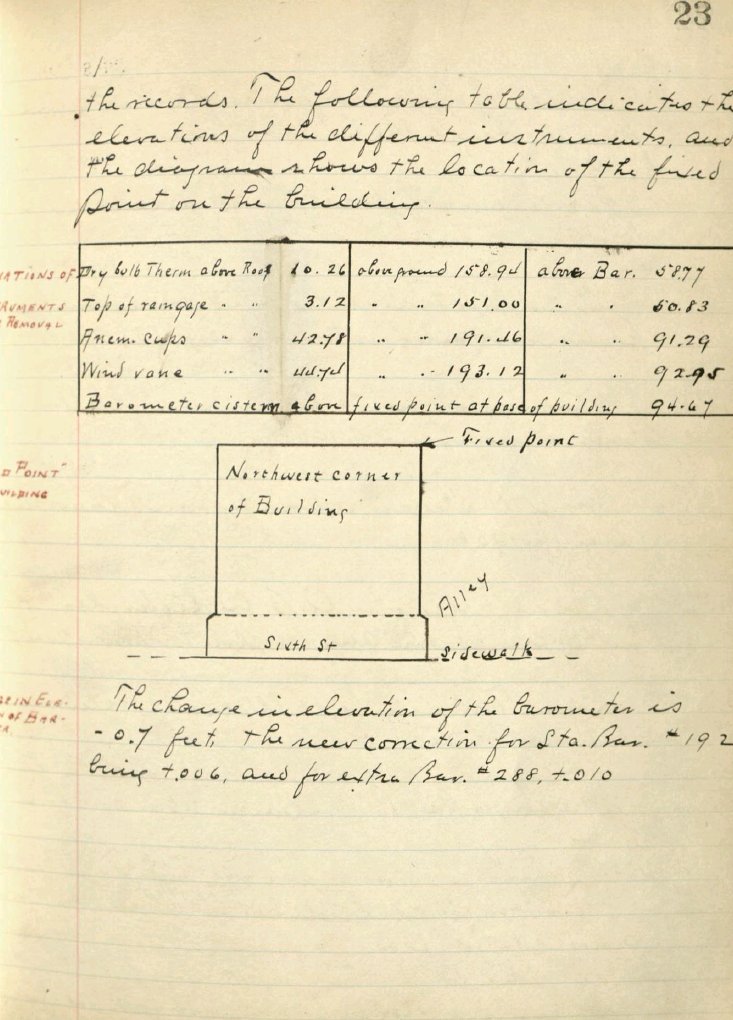
View Additional Pages (PDF)
View Accessible Text Transcript (PDF)
To Wong Foo, Thanks for Everything! Julie Newmar (1995)
Three New York City drag queens, Noxeema, Vida, and newcomer Chi-Chi, journey across the country to follow their dream of competing in the Miss Drag Queen of America Pageant in Los Angeles and living their most authentic lives. Along the way, an encounter with a rural sheriff and car troubles delay them. They stay in a small town for an eventful weekend before continuing to Los Angeles where Chi-Chi successfully shows off everything she learned from Vida and Noxeema. To Wong Foo, Thanks for Everything! Julie Newmar is a Hollywood fairy tale, embodying Hollywood’s promise as a place of hope and opportunity where dreams come true, an idea evident in Noxeema's proclamation, "From now on, I’m not gonna worry about whether people accept me or not. I'm gonna make Hollywood wherever I am at." In Los Angeles, Noxeema, Vida, and Chi-Chi achieve their dreams, finding acceptance and love of their true selves.
LGBTQ+ Representation and the Hollywood Hyperreality in To Wong Foo, Thanks For Everything! Julie Newmar
LGBTQ+ Representation and the Hollywood Hyperreality in To Wong Foo, Thanks For Everything! Julie Newmar (Audio transcript )
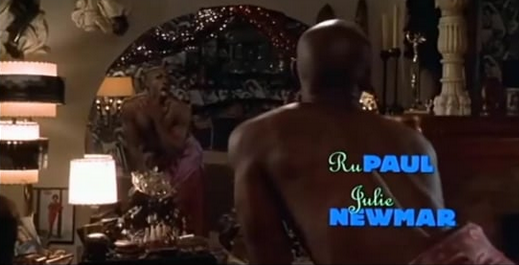
Miss Southern California
Miss Southern California illustrates the endpoint of Vida, Noxeema, and Chi-Chi’s journey, both literally and symbolically, though it was produced in 2004 rather than the 1990s. The book includes relevant information on the 2004 pageant, including registration fees, an application form, schedule, and official rules and evaluation criteria. The pageant required entrants to be transgender persons and/or drag illusionists. For the To Wong Foo protagonists, the drag pageant is the practical reason for their road trip, but symbolically it represents their arrival as the queens they always knew they could be. They had made it!
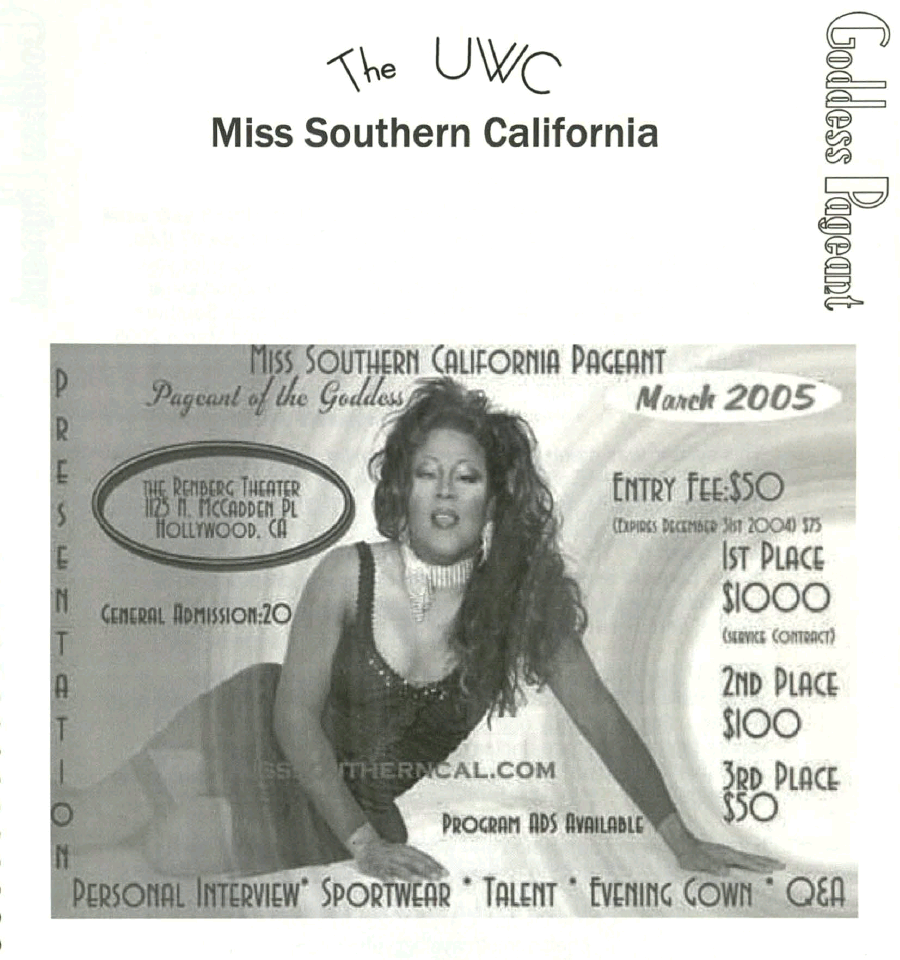
View Additional Pages (PDF)
Female Mimics Magazine
This issue of Female Mimics Magazine depicts members of the Jewel Box Revue, a troupe of "female impersonators," highlighting Dale Roberts, the winner of a New York beauty pageant. This mid-20th century publication shows many unnamed members of the troupe preparing for their performance. These images depict some of the preparations these drag queens undertook before performing, similar to the opening credits of To Wong Foo. At the time of the publication of Female Mimics Magazine, many mainstream American films, like Alfred Hitchcock's Psycho, presented male characters in drag as an element of horror or comedy. By the 1990s, drag in film was increasingly portrayed not as a threat, but with greater dignity as an upbeat and consciousness-raising element of a film plot.

View Additional Pages (PDF)
Hollywood Walk of Fame
Actor George Takei's life and film career epitomizes the Hollywood ending in many respects. At the age of five, he and his family were incarcerated in concentration camps because of their Japanese ancestry. The government stripped his family of their belongings at the time of their incarceration. After the war, they lived on Los Angeles’ Skid Row for five years before being financially able to settle in a new neighborhood when George was approximately thirteen years old. Despite these early challenges, Takei went to college and found fame as helmsman and third-officer Sulu in Star Trek. Today he has a successful acting career and is active in local politics and the LQBTQA+ community. For Takei and the protagonists in To Wong Foo, although acceptance does not come easily, Hollywood is a site of opportunity.
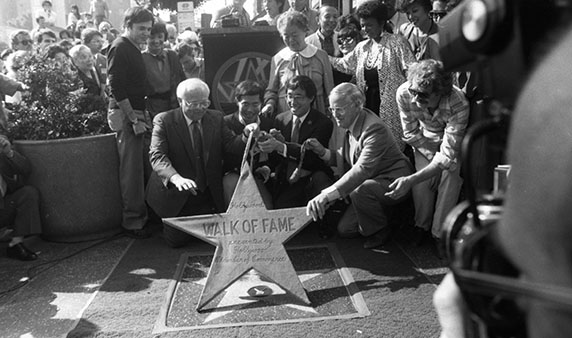
Once Upon a Time… in Hollywood (2019)
In Once Upon a Time...in Hollywood, director Quentin Tarantino creates an alternate history of the infamous Manson Family murders that shattered Hollywood's glamorous mid-20th century veneer. Set in 1969, the film centers on the experiences of aging actor Rick Dalton and his stunt double Cliff Booth. Dalton struggles to come to terms with his slow slide into Hollywood history as the industry changes, he is relegated to starring in Spaghetti Westerns, and Booth struggles to find paid work due to a damaged reputation. The rise of hippie and cult culture looms on the periphery, before crashing into the film's foreground as members of the Manson Family arrive in Dalton's neighborhood to murder actress Sharon Tate and four of her friends. Tarantino's alternative version of these events allows both Dalton and Booth to be heroes one more time. The film's ending is both hopeful and happy, presenting Hollywood as a place where even has-beens get second chances.
World’s Championship Rodeo
Since the late-18th century, vaquero or cowboy culture has been a mainstay in California. The cowboy image in the American imagination was heavily derived from popular culture references in literature and film in the 19th and 20th centuries. The Western film genre was especially popular in the early and mid-20th century. Gene Autry, depicted on this 1949 program cover, was a well-known and popular Western star, famous for his singing and acting roles in film and later on television. Like other Western stars that catapulted into popularity with film and television roles, Rick Dalton in Once Upon a Time...in Hollywood became famous through starring in a fictional 1950s Western television show, Bounty Law.
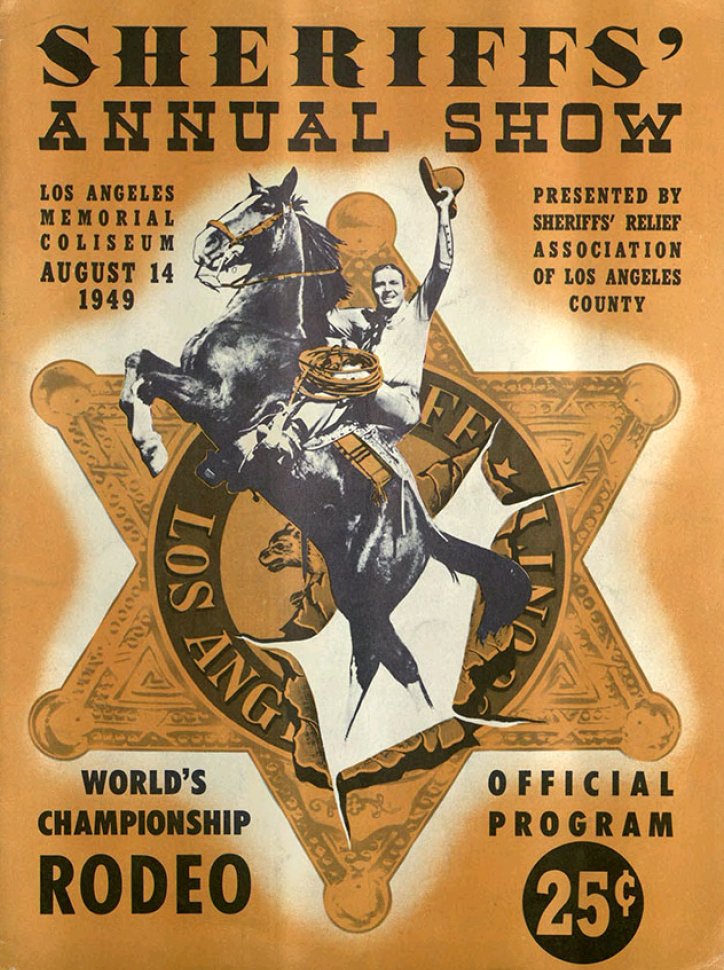
View Document (PDF)
Spahn Ranch
Spahn Ranch is north and slightly east of the Chatsworth Reservoir. George Spahn purchased the ranch in 1953, added horseback riding, and built up an existing Western film set. Television shows filmed at Spahn Ranch include The Lone Ranger and several episodes of Bonanza. When Western film production slowed in the late 1960s, guided horseback riding kept the ranch financially afloat. Cult leader Charles Manson and his followers moved to the Ranch in August 1968, and like in Once Upon a Time...in Hollywood, helped Spahn run horseback riding operations in exchange for free rent. In 1970, a fire destroyed the Western town structures, and today the land is part of Santa Susana State Historic Park. Spahn Ranch embodies 1969 Los Angeles as a crossroads between the waning Western film genre and the rise of hippie and alternative cultures.
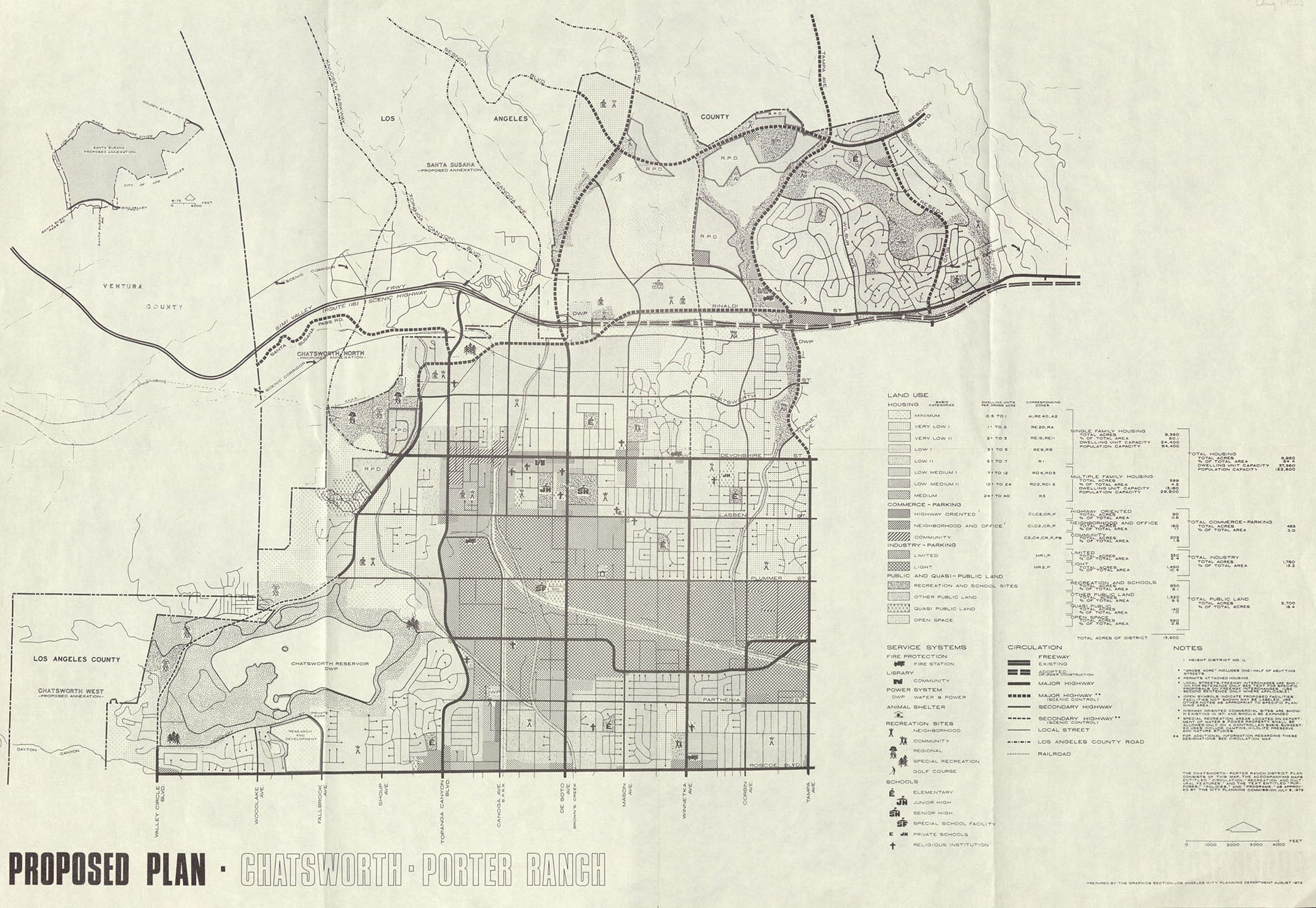
Charles Manson
Cult leader Charles Manson led his followers to commit nine murders in Los Angeles in July and August 1969. When his trial started in June 1970, some members of the counterculture movement considered Manson a hero, including artist Nancy Jo Davis, who created this depiction of Manson in a Christ-like pose. Beyond works of art like this one, counterculture occult newspaper Tuesday’s Child named Manson Man of the Year. In stark contrast to Davis’ reverence for Manson, Rick Dalton and Cliff Booth in Once Upon a Time...in Hollywood fought back against the Manson Family’s incursion into the Hollywood dream, and beat the murderous Family members into a flambéed pulp.
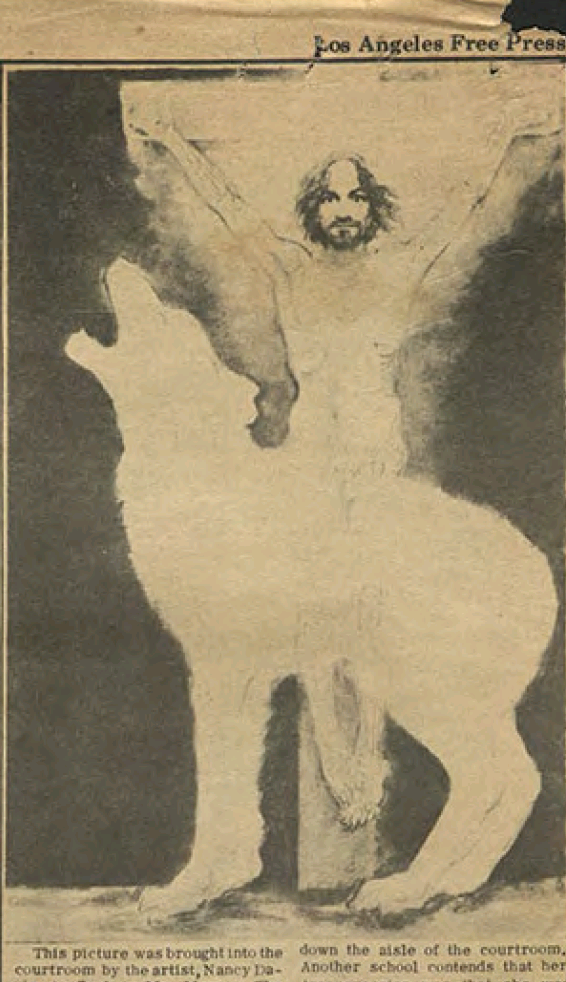
View Document (PDF)




